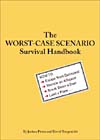
Comment
on this story
|
 |

New handbook offers explicit directions for survival
by Jeanne McDonald
Say you've discovered that your husband has taken out an enormous insurance policy on your life, and you receive an oily package, tied with string and heavily taped. Or what if you've just fired a volatile employee who has threatened to seek revenge; then a box arrives, leaking, stained, and studded with protruding wires? Should you be suspicious? Absolutely. But never fear. The Worst Case Scenario Survival Handbook by Joshua Piven and David Borgenicht (Chronicle Books, $14.95) tells you how to identify a bomb (page 94) and how to detect explosives (page 96), but on page 98 suggests that, first, you call the bomb squad.

In fact, this fascinating little book is full of disclaimers, disavowals, and renunciations of liability. No wonder, because otherwise, how would the authors deal with the countless lawsuits that might result if people actually followed all the step-by-step instructions that the cover cites as "what you need to know fast?" Some people, especially the self-confidence impaired, will feel compelled to carry it everywhere. Because who knows when you might have to deliver a baby in a taxicab, jump from a moving car, or wrestle an alligator?
Trouble is, with most of these survival tactics, you need equipment—some sophisticated, some elementary, but few can be performed without tools. For example, Tom Hanks would have fared much better in the movie Cast Away if he'd taken along the equipment the authors suggest, and (heads up, Tom) if he had anticipated that his plane might go down in the South Pacific and that he'd be stranded on a tropical island for four years with only a shipwrecked volleyball to talk to. What in the world could Tom have been thinking? Not only did he forget plastic jugs filled with water, he never even considered canned vegetables, which, the authors note, are packed in water. And did Tom ponder for a millisecond fashioning a fishhook from an aluminum can? Furthermore, did he ever think of packing a VHF radio or flare gun? Nooooo. Worse, he ignored instructions to carry along a box of aluminum foil, which we all know could have been used as a signaling device.
Now, "How to Perform a Tracheotomy" requires much simpler tools: a razor or sharp knife and a straw or ballpoint pen, which, of course, we carry at all times in our pockets or purses. The authors' disclaimer here reads, "There will not be time for sterilization of your tools, so do not bother; infection is the least of your worries at this point." I should say so.
Instructions for delivering a baby in a taxicab are pretty straightforward, too. You need only clean, dry towels (got one right here) or a clean shirt, which, by the way, you can also use for dealing with a charging bull. "It does not matter what color the clothing is," the authors say blithely. This, after warning, in red print, "Do not antagonize the bull, and do not move." Are they kidding? On the next page they say: "If you encounter a stampede of bulls or cattle, do not try to distract them. Try to determine where they are headed, and then get out of the way." Thank God for such explicit directions; else, how would we have known?
Initially I was excited by the chapter title, "How to Avoid Being Struck by Lightning," until I read, "Loud or frequent thunder indicates that lightning activity is approaching." Uh-huh. And, "If you are on a technical climb, sit on a rock or on nonmetallic equipment. Tie a rope around your ankle; this will anchor you if a strike occurs and you are knocked off balance." Thanks, guys.
"...[K]eep this book on hand at all times," the authors suggest ominously. Okay, but wait until I collect a few tools: a large limb for keeping afloat in quicksand; a wooden broom handle to rescue a person being electrocuted by a live wire; a portable defibrillator to restore heartbeats; a Polaroid radiographic film cassette and processor to photograph suspicious packages; sterile dressings and hydrogen peroxide for random bullet wounds; and a good pair of running shoes to "[t]urn a corner as quickly as you can, particularly if your pursuer has a rifle or assault weapon."
Before I read the small print, I had thought that the one place I might carry my Handbook was on an airplane flight, but "How to Land a Plane" bears yet another disclaimer: "These instructions cover small passenger planes and jets (not commercial airliners)."
Damn. I was already practicing the routine: Drag the incapacitated pilot from his seat, put on the headset (if there is one), press the control button to talk, release it to listen. Or, wait a minute. Is it the other way around?
Anyway, this part I remember: "Mayday! Mayday! Mayday!"

January 18, 2001 * Vol. 11, No. 3
© 2001 Metro Pulse
|